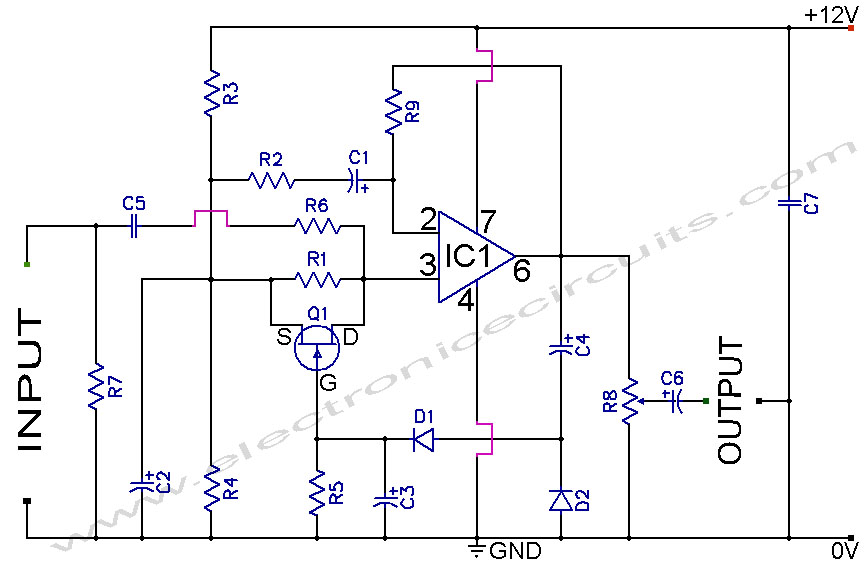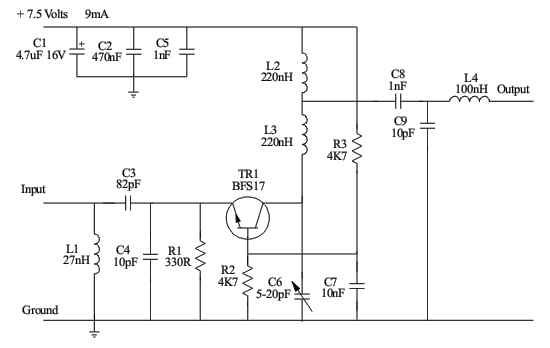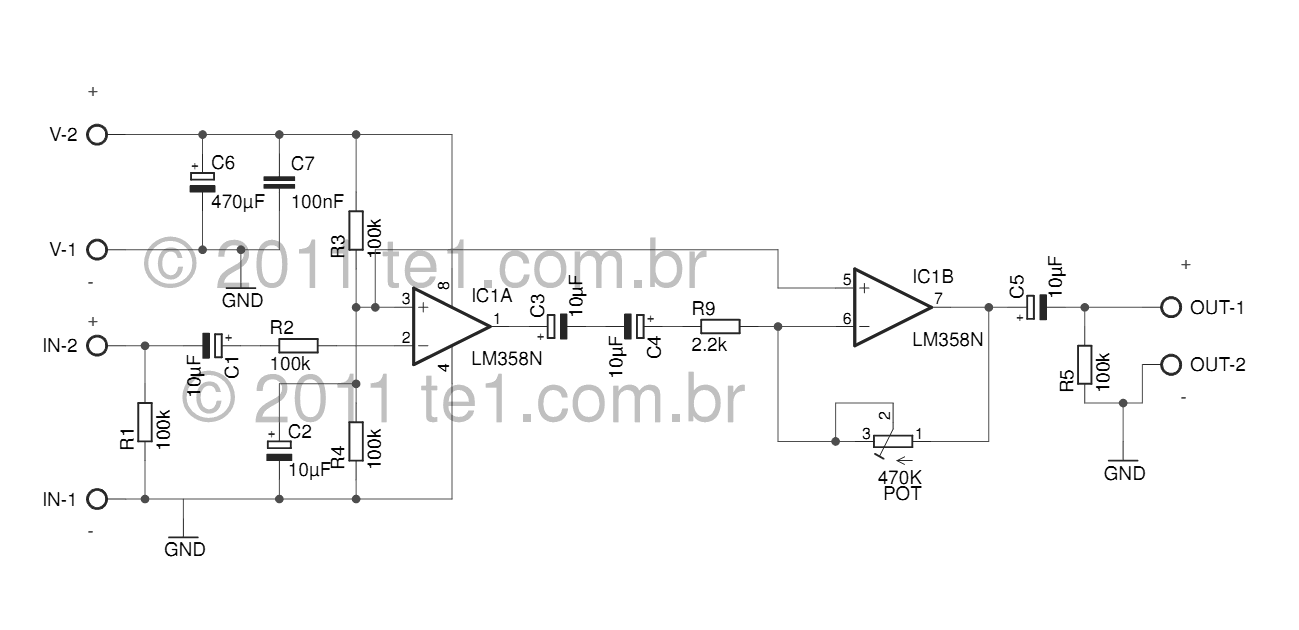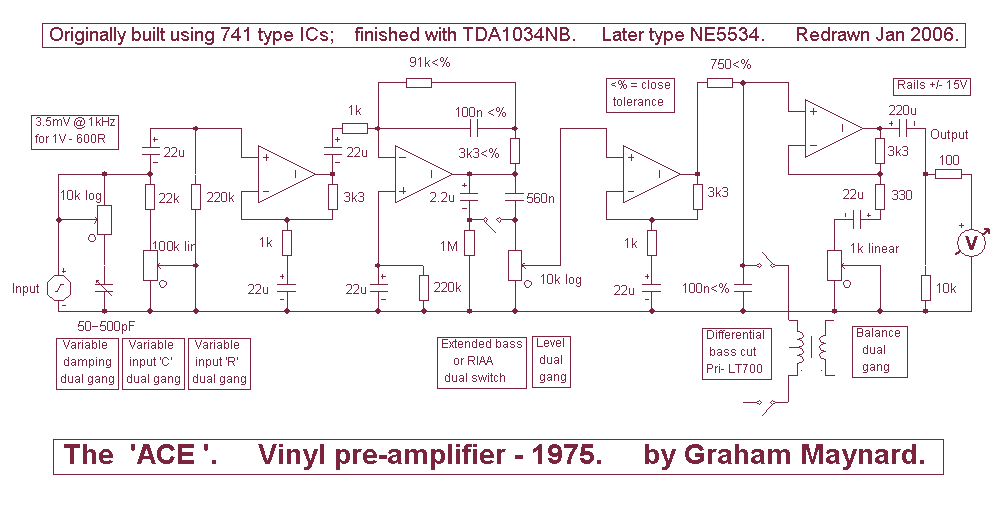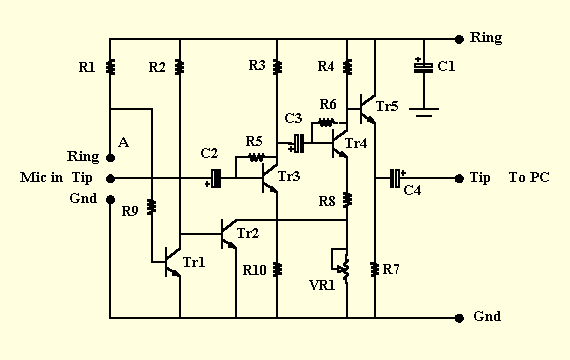
SW RF Pre-Amplifier
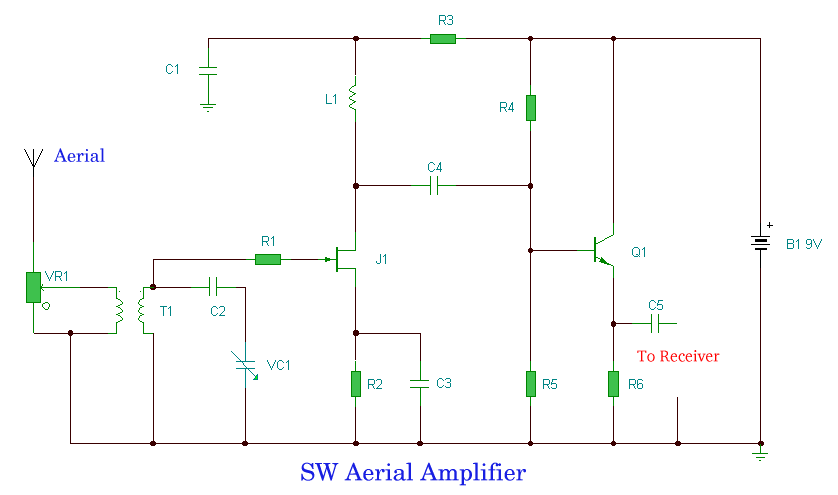
Amplifying weak radio signals presents the challenge of also amplifying noise. The ability to receive signals is contingent on the level of background noise, which can include man-made interference or static. In this design, the RF signal first encounters a resistive attenuator to prevent strong signals from overloading the receiver. The transformer T1 is wound on a 1-inch diameter ferrite loop, with the primary (antenna side) consisting of 2 turns of 22 SWG wire and the secondary comprising 4 turns of 22 SWG wire, spaced to occupy approximately half the coil's circumference. The secondary's inductance is approximately 20 µH. To tune the circuit for frequencies between 5 to 20 MHz, a capacitor with a range from around 3 pF to 200 pF is necessary. A standard capacitor of 400 or 500 pF can be utilized alongside a series capacitor, C2. Capacitors in series function similarly to resistors in parallel, with the smallest capacitance being just below the smallest capacitor in the series and the highest value slightly below the highest capacitance. Using a 220 pF capacitor for C2 and a 500 pF variable capacitor (tuning down to 5 pF), the effective capacitance can be adjusted from approximately 143 pF to about 4.8 pF. This tuning is approximate and not critical, as the gain of the FET amplifies frequencies outside the tuned circuit range. The 2N3819 FET operates in a common-source configuration, with a series base resistor R1 included to stabilize the response; this resistor increases the internal gate-source impedance at higher frequencies. The drain circuit features a 2.5 mH choke, although a 4.7 mH choke can also be used. Due to the high Q factor of these coils, a series resistor R3 is added to flatten the response. The frequency response is calculated at 10% increments of VC1. The output impedance from the FET is high, necessitating buffering by a BC108C in emitter follower mode. The current drain is approximately 3 mA from a 9 Volt battery. As is typical with RF circuits, sensitivity to noise and interference is a concern; therefore, housing the circuit in a metal or aluminum box is advisable. Nevertheless, the circuit performed well on a breadboard, effectively boosting weak signals.
The circuit design incorporates several key components to ensure optimal performance in amplifying weak radio signals while minimizing noise interference. The resistive attenuator at the input stage is crucial for protecting the receiver from strong signals that could lead to distortion or damage. The transformer, T1, serves as the main coupling device, with its carefully calculated turns ratio and inductance values tailored for the desired frequency range. The selection of wire gauge (22 SWG) is significant in balancing the resistance and inductance characteristics of the transformer.
The tuning capacitor configuration allows for fine adjustments across a critical frequency range. The use of a variable capacitor in conjunction with a fixed capacitor enables a flexible tuning mechanism. The calculation of effective capacitance when capacitors are placed in series is essential for achieving the desired resonance frequency, which directly influences the circuit's selectivity and sensitivity.
The 2N3819 FET, operating in common-source mode, is chosen for its high gain characteristics, which are vital for amplifying weak signals. The inclusion of a series base resistor (R1) is a common practice in RF design to mitigate high-frequency response issues, ensuring that the circuit remains stable across its operational bandwidth. The addition of a choke in the drain circuit helps to maintain the integrity of the amplified signal while managing the load presented to the FET.
The output stage, utilizing the BC108C transistor in an emitter follower configuration, effectively buffers the high output impedance of the FET, allowing for better interfacing with subsequent stages or output loads. The overall current consumption of approximately 3 mA from a 9 Volt source indicates a low-power design, suitable for portable applications.
To enhance performance, the circuit should be housed in a shielded enclosure to reduce susceptibility to external noise and interference, which is a common issue in RF applications. The successful operation of the circuit on a breadboard indicates its robustness and effectiveness in boosting weak radio signals.The problem with amplifying weak radio signals is that you also amplify the noise. What you can receive depends on how much background noise is present, whether it be man made interference or static. In this design the RF signal is first met by a resistive attenuator, this is necessary as strong signals could otherwise overload your receiver.
The transformer T1 is would on a 1 inch diameter ferrite loop. The primary (antenna side) is 2 turns of 22 swg wire. The secondary is 4 turns of 22 swg wire. The 4 turns are spaced to occupy roughly half the coils circumference. The approximate inductance of the secondary is 20uH. To cover 5 to 20 Mhz a capacitor tuning from around 3pF to 200pF is required. A standard capacitor of 400 or 500pF (full mesh) can be used by including a series capacitor, C2 in the above Capacitors. Capacitors in series behave the same as resistors in parallel. The smallest capacitance is just less than the smallest capacitor in series and highest value also less than the highest capacitance.
With a 220pF capacitor for C2 and a 500pF variable capacitor (that tunes down to 5pF) the effective capacitance tunes 143pF to about 4. 8pF. This is roughly correct and not critical as the gain of the FET will amplify frequencies outside the tuned circuit range.
The 2N3819 FET operates in common source. The series base resistor R1 is included to even out the response, the internal gate source impedance is thus increased by R1 at higher frequencies. The drain circuit includes a 2. 5mH choke. A 4. 7mH can also be used. As the Q factor of these coils are high, a series resistor R3 is introduced to flatten the response. The frequency response is shown below calculated at 10% increments of VC1: The output impedance from the FET is high, so is buffered by the BC108C in emitter follower mode.
Current drain is around 3mA from a 9 Volt battery. As with any RF circuit, the circuit is sensitive to noise and interference. A metal or aluminum box would be a good choice for this project. However, on my trusty breadboard, this circuit preformed well, and weak signals were boosted well. 🔗 External reference
The circuit design incorporates several key components to ensure optimal performance in amplifying weak radio signals while minimizing noise interference. The resistive attenuator at the input stage is crucial for protecting the receiver from strong signals that could lead to distortion or damage. The transformer, T1, serves as the main coupling device, with its carefully calculated turns ratio and inductance values tailored for the desired frequency range. The selection of wire gauge (22 SWG) is significant in balancing the resistance and inductance characteristics of the transformer.
The tuning capacitor configuration allows for fine adjustments across a critical frequency range. The use of a variable capacitor in conjunction with a fixed capacitor enables a flexible tuning mechanism. The calculation of effective capacitance when capacitors are placed in series is essential for achieving the desired resonance frequency, which directly influences the circuit's selectivity and sensitivity.
The 2N3819 FET, operating in common-source mode, is chosen for its high gain characteristics, which are vital for amplifying weak signals. The inclusion of a series base resistor (R1) is a common practice in RF design to mitigate high-frequency response issues, ensuring that the circuit remains stable across its operational bandwidth. The addition of a choke in the drain circuit helps to maintain the integrity of the amplified signal while managing the load presented to the FET.
The output stage, utilizing the BC108C transistor in an emitter follower configuration, effectively buffers the high output impedance of the FET, allowing for better interfacing with subsequent stages or output loads. The overall current consumption of approximately 3 mA from a 9 Volt source indicates a low-power design, suitable for portable applications.
To enhance performance, the circuit should be housed in a shielded enclosure to reduce susceptibility to external noise and interference, which is a common issue in RF applications. The successful operation of the circuit on a breadboard indicates its robustness and effectiveness in boosting weak radio signals.The problem with amplifying weak radio signals is that you also amplify the noise. What you can receive depends on how much background noise is present, whether it be man made interference or static. In this design the RF signal is first met by a resistive attenuator, this is necessary as strong signals could otherwise overload your receiver.
The transformer T1 is would on a 1 inch diameter ferrite loop. The primary (antenna side) is 2 turns of 22 swg wire. The secondary is 4 turns of 22 swg wire. The 4 turns are spaced to occupy roughly half the coils circumference. The approximate inductance of the secondary is 20uH. To cover 5 to 20 Mhz a capacitor tuning from around 3pF to 200pF is required. A standard capacitor of 400 or 500pF (full mesh) can be used by including a series capacitor, C2 in the above Capacitors. Capacitors in series behave the same as resistors in parallel. The smallest capacitance is just less than the smallest capacitor in series and highest value also less than the highest capacitance.
With a 220pF capacitor for C2 and a 500pF variable capacitor (that tunes down to 5pF) the effective capacitance tunes 143pF to about 4. 8pF. This is roughly correct and not critical as the gain of the FET will amplify frequencies outside the tuned circuit range.
The 2N3819 FET operates in common source. The series base resistor R1 is included to even out the response, the internal gate source impedance is thus increased by R1 at higher frequencies. The drain circuit includes a 2. 5mH choke. A 4. 7mH can also be used. As the Q factor of these coils are high, a series resistor R3 is introduced to flatten the response. The frequency response is shown below calculated at 10% increments of VC1: The output impedance from the FET is high, so is buffered by the BC108C in emitter follower mode.
Current drain is around 3mA from a 9 Volt battery. As with any RF circuit, the circuit is sensitive to noise and interference. A metal or aluminum box would be a good choice for this project. However, on my trusty breadboard, this circuit preformed well, and weak signals were boosted well. 🔗 External reference
